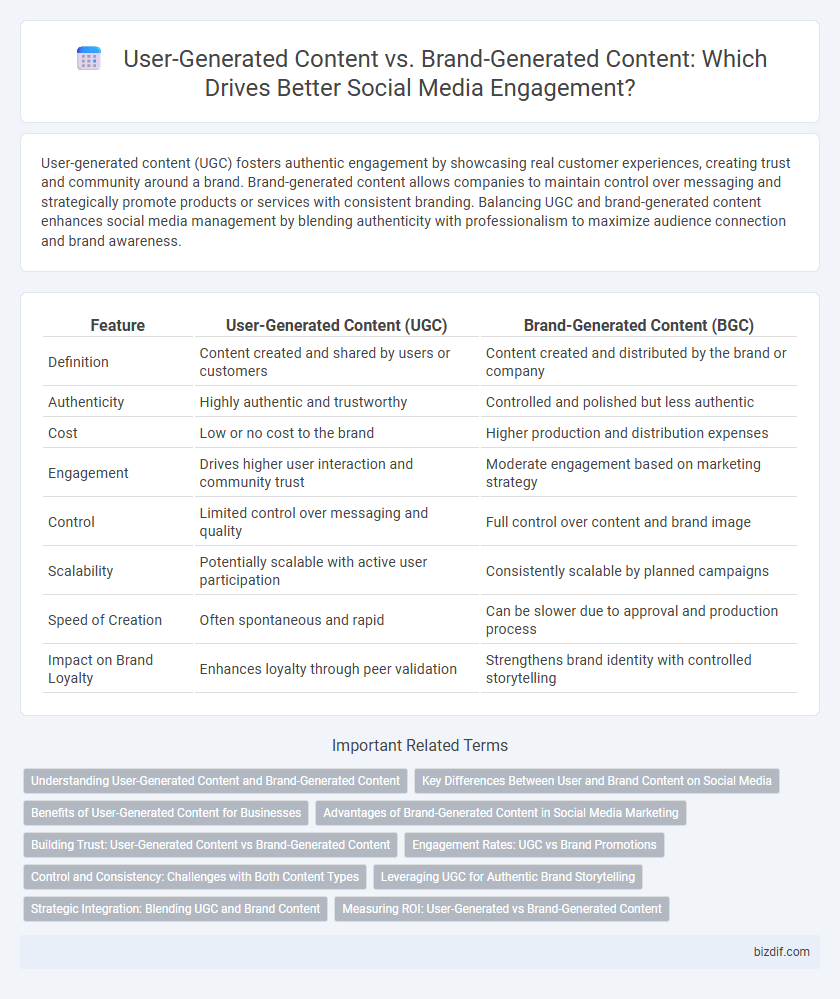User-generated content (UGC) fosters authentic engagement by showcasing real customer experiences, creating trust and community around a brand. Brand-generated content allows companies to maintain control over messaging and strategically promote products or services with consistent branding. Balancing UGC and brand-generated content enhances social media management by blending authenticity with professionalism to maximize audience connection and brand awareness.
Table of Comparison
| Feature | User-Generated Content (UGC) | Brand-Generated Content (BGC) |
|---|---|---|
| Definition | Content created and shared by users or customers | Content created and distributed by the brand or company |
| Authenticity | Highly authentic and trustworthy | Controlled and polished but less authentic |
| Cost | Low or no cost to the brand | Higher production and distribution expenses |
| Engagement | Drives higher user interaction and community trust | Moderate engagement based on marketing strategy |
| Control | Limited control over messaging and quality | Full control over content and brand image |
| Scalability | Potentially scalable with active user participation | Consistently scalable by planned campaigns |
| Speed of Creation | Often spontaneous and rapid | Can be slower due to approval and production process |
| Impact on Brand Loyalty | Enhances loyalty through peer validation | Strengthens brand identity with controlled storytelling |
Understanding User-Generated Content and Brand-Generated Content
User-generated content (UGC) comprises authentic posts, reviews, and media created by customers, amplifying trust and engagement through real experiences. Brand-generated content (BGC) involves strategically crafted messages, advertisements, and storytelling controlled by companies to shape brand identity and promote products. Leveraging the strengths of UGC and BGC together enhances social media management by balancing credibility with consistent brand messaging.
Key Differences Between User and Brand Content on Social Media
User-generated content (UGC) is created by customers or followers, offering authentic, relatable experiences that enhance credibility and trust on social media platforms. Brand-generated content (BGC), crafted by companies, delivers consistent messaging aligned with marketing goals to promote products or services strategically. The key differences lie in origin, authenticity, and purpose: UGC fosters community engagement through genuine voices, while BGC ensures controlled, branded storytelling to drive awareness and conversions.
Benefits of User-Generated Content for Businesses
User-generated content (UGC) significantly boosts brand authenticity and trust, leading to higher engagement rates on social media platforms. Businesses benefit from cost-effective content creation, as UGC reduces the need for extensive in-house production while expanding reach through organic sharing. Leveraging UGC also enhances customer loyalty and provides valuable insights into consumer preferences, driving more targeted marketing strategies.
Advantages of Brand-Generated Content in Social Media Marketing
Brand-generated content ensures consistent messaging and maintains a cohesive brand identity across social media platforms, enhancing recognition and trust. It allows precise control over the quality and style of posts, aligning with strategic marketing goals and target audience preferences. This type of content supports optimized SEO performance by incorporating relevant keywords and branded hashtags, driving higher engagement and visibility.
Building Trust: User-Generated Content vs Brand-Generated Content
User-generated content (UGC) fosters higher trust by showcasing authentic experiences and genuine customer voices, making audiences more likely to engage and convert. Brand-generated content, while polished and controlled, often lacks the perceived credibility that organic user testimonials provide. Leveraging UGC alongside strategic brand messaging creates a powerful trust-building dynamic that drives brand loyalty and enhances social proof.
Engagement Rates: UGC vs Brand Promotions
User-generated content (UGC) consistently achieves higher engagement rates compared to brand-generated content, with studies showing UGC can boost interactions by up to 28%. Authenticity in UGC fosters trust and community connection, leading to increased likes, shares, and comments. Brand promotions often receive lower engagement due to their polished nature, which can feel less relatable to audiences on platforms like Instagram and TikTok.
Control and Consistency: Challenges with Both Content Types
User-generated content offers authentic engagement but poses challenges in maintaining consistent brand messaging due to limited control over the content's tone and quality. Brand-generated content ensures alignment with marketing objectives and brand guidelines but may lack the spontaneity and trustworthiness of user contributions. Balancing control and consistency requires strategic moderation and clear content policies to maximize impact across social media platforms.
Leveraging UGC for Authentic Brand Storytelling
User-generated content (UGC) enhances brand storytelling by showcasing authentic customer experiences, increasing trust and engagement on social media platforms. Brands leveraging UGC can amplify their reach by encouraging followers to share genuine reviews, photos, and videos, creating a community-driven narrative that resonates deeply with target audiences. Studies show UGC-driven posts receive 28% higher engagement rates, making it a strategic asset for authentic brand communication.
Strategic Integration: Blending UGC and Brand Content
Blending user-generated content (UGC) with brand-generated content enhances social media engagement by combining authentic customer experiences with consistent brand messaging. Strategic integration leverages UGC to build trust while using brand content to maintain narrative control and showcase product benefits. This balanced approach maximizes reach and fosters community loyalty, driving higher conversion rates and sustained audience growth.
Measuring ROI: User-Generated vs Brand-Generated Content
Measuring ROI in social media management reveals user-generated content (UGC) often drives higher engagement rates and authentic brand advocacy compared to brand-generated content, which typically requires larger upfront costs for content creation and promotion. Analytics tools track metrics like conversion rates, customer acquisition cost, and lifetime value to assess the effectiveness of UGC in fostering trust and community growth, while brand-generated content provides controlled messaging and consistent branding. Balancing both content types maximizes ROI by leveraging UGC's credibility and brand-generated content's strategic messaging to enhance overall campaign performance.
User-generated content vs Brand-generated content Infographic

 bizdif.com
bizdif.com